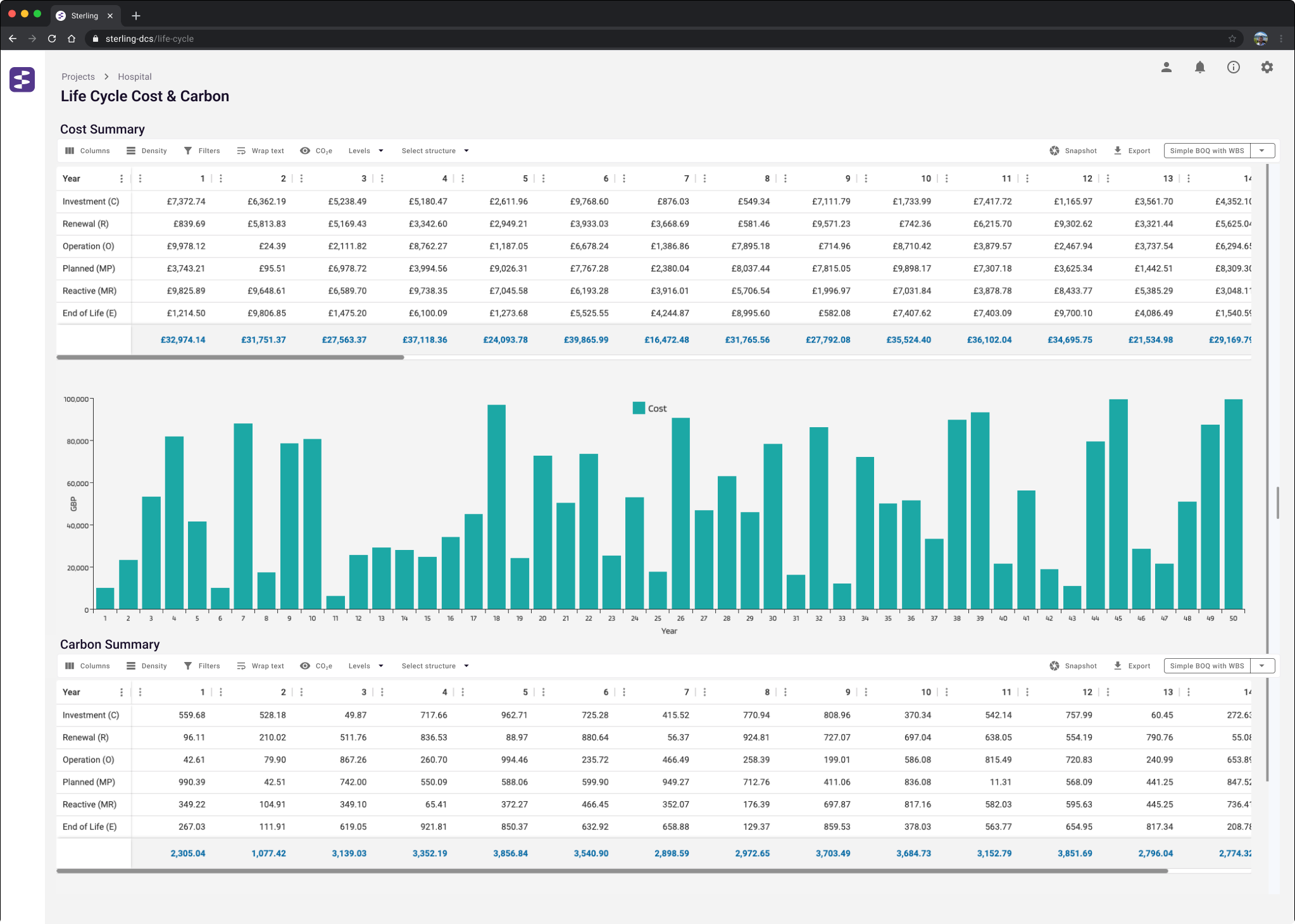Life Cycle
In the dynamic landscape of construction and infrastructure development, life cycle estimating emerges as a pivotal tool. Unlike traditional approaches that focus solely on the initial capital phase, life cycle estimating takes a holistic view, spanning the entire project journey. Here’s how Sterling underpins your life cycle insights driving better results.
Optimised decision making involves considering a project’s entire life cycle, from its inception to decommissioning. Sterling’s comprehensive approach enables project stakeholders to grasp the full spectrum of costs, risks, and environmental impacts, thereby facilitating informed decision-making that aligns with long-term goals and sustainability objectives.
Within Sterling, holistic impact consideration is prioritised. Instead of isolating impacts to specific project phases, a holistic view is maintained throughout the project’s life cycle. This strategy helps prevent unintended errors as the project scope matures and fosters consistent decision-making practices.
Furthermore, within Sterling, feasibility evaluation is achieved through the integration of life cycle cost and carbon (LCCC) during the capital project. This ensures that feasibility assessments extend beyond the construction phase to include ongoing operational costs, maintenance, and overall performance. Consequently, this approach leads to more robust project outcomes.
Sterling’s life cycle estimating facilitates adaptive adjustments. As the project evolves, project requirements evolve accordingly. Life cycle estimating allows for adaptive adjustments, ensuring that projects remain relevant, efficient, and aligned with organisational objectives throughout their life cycle.
Sterling follows the CROME sequence (Capital, Renewal, Operation, Maintenance, and End of Life), which is accepted as the main activity categories. This structured approach ensures clarity and transparency, preventing you from feeling overwhelmed when assessing the entire life cycle. By focusing on key elements, Sterling enables you to prioritise and maximise both capital investment and long-term value.
Features
Renewal – Within Sterling, users have the flexibility to determine the level of detail they need when estimating typical repair costs and the carbon attributed to the activities. This can range from a simple percentage taken from the capital estimate to a detailed breakdown of all resources involved. Repair outcomes include the cost and carbon values incurred to fix or restore elements of a built asset during its operational life, typically due to wear, damage, or deterioration. Ensuring robust and transparent estimates of repair costs is crucial for effective asset management planning, as it minimises disruptions and promotes the longevity of the asset.
Operations – Operational costs cover the day-to-day expenses involved in running and maintaining an asset, including utilities, staffing, security, and routine upkeep. This comprehensive understanding of operational costs is crucial for effective budgeting, optimising efficiency, and achieving sustainable performance goals.
Sterling’s operational cost and carbon values are calculated based on several pre-defined categories for cleaning and janitorial services, utilities, waste management, security, environmental protection measures, information and communication technology, operational cost, and carbon, as well as client-defined parameters.
Maintenance – Maintenance costs encompass preventive and corrective actions aimed at maintaining an asset’s optimal functionality, including regular inspections, servicing, and minor repairs. By implementing proper maintenance practices, Sterling users can mitigate unexpected breakdowns, prolong asset life, and enhance overall safety measures.
Planned – Sterling empowers users to create maintenance activities using their corporate knowledge and experience. Where applicable, users can also integrate equipment maintenance plans provided by manufacturers with the hours needed to undertake the maintenance procedure and the required material spares, including part numbers, along with industry maintenance standards driven by health and safety considerations into their maintenance strategies.
Reactive – At Sterling, we acknowledge the importance of considering unplanned, reactive maintenance when evaluating an asset’s management plan. To accommodate this, our platform offers a straightforward solution: users can define anticipated maintenance interventions and apply percentages of the capital estimate or input typical values based on their own experience to allow for reactive maintenance. Users have the flexibility to add as many unplanned activities as necessary, ensuring a comprehensive approach to estimating maintenance costs.
End of Life – Within Sterling, we ensure comprehensive coverage of all aspects of end of life costs by incorporating the 4 carbon categories. These costs encompass the decommissioning, disposal, or replacement of an asset as it nears the end of its useful life. This includes activities such as dismantling, environmental cleanup, and transitioning to a new asset, ensuring that users have a holistic understanding of the financial implications associated with the entire life cycle of an asset.
Benefits
- Inform the Capital Design By predicting Life Cycle cost and carbon values during the asset design phase, we ensure that future significant cost and carbon values are appropriately aligned with the client's expectations and legislative requirements.
- Accurate Life Cycle Planning Sterling facilitates accurate life cycle planning by providing estimators with precise insights into through-life costs, integrating carbon data to strategically plan the asset management interventions and ensure optimal asset longevity, ultimately minimising surprises during renewal phases.
- Efficient Budget Allocation Sterling enables efficient budget allocation for operations by allowing estimators to effectively allocate resources for day-to-day operations. It utilises integrated cost and carbon data for transparent budgeting and allows the life cycle assessor to refine the annual asset maintenance costs should the client require this.
- Maintenance Sterling facilitates the estimation of all maintenance activities across the asset by providing estimators with the opportunity to detail the equipment and building maintenance requirements. This allows them to focus on the big-ticket planned maintenance activities based on cost and carbon emissions data, thus reducing downtime and enhancing reliability. Additionally, Sterling's intuitive reporting ensures that users can identify maintenance hot spots and refine the annual total maintenance values.
- Responsible Decommissioning Within Sterling, estimators can build their plan for end of life activities, and this plan can be at multiple levels of detail. Sterling includes dismantling, disposal, and environmental cleanup, ensuring compliance with legislation. Sterling factors these costs and carbon values transparently into the overall budget.
Want to see the new features in action?
Contact our Sales team today to schedule a call to discuss your requirements.

